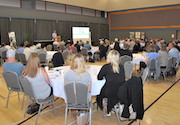| |
| |
 |
 |
| |
 |
|
June 25, 2019 |
|
| |
 Dust Safety Week 2019 is here! For a full five days Canadian Biomass and Canadian Forest Industries are focused on best practices, technical information and solutions for keeping pellet and sawmill operations safe.
» Read more...
Dust Safety Week 2019 is here! For a full five days Canadian Biomass and Canadian Forest Industries are focused on best practices, technical information and solutions for keeping pellet and sawmill operations safe.
» Read more...
The BC Forest Safety Council takes a look at the progress sawmills in B.C., have made in combustible dust mitigation and control since 2012.
» Read more...
Speakers at WPAC’s workshop Silo Fires – Prevention and Response discussed a range of topics, including covered silo firefighting procedures, nitrogen supply and injection equipment, foam injection, case studies and more. Check out some key takeaways from the event.
» Read more...
Canadian Biomass highlights some of the newest technology for collecting and suppressing combustible dust in pellet mills.
» Read more...
Smoldering fires produce flammable pyrolysis gasses, which can travel and accumulate. The release of carbon dioxide from high-pressure cylinders can generate static electricity with sufficient energy to ignite the pyrolysis gases. Consequently, using carbon to suppress silo fires is unsafe.
» Read more...
|
| |
|
| |
 At the Wood Products Safety Summit on June 11 in Prince George, B.C., nearly 100 attendees gathered to hear lessons learned and learn safety best practices, including how to create a safety culture and technical combustible dust presentations.
» Read more...
At the Wood Products Safety Summit on June 11 in Prince George, B.C., nearly 100 attendees gathered to hear lessons learned and learn safety best practices, including how to create a safety culture and technical combustible dust presentations.
» Read more... |
| |
 One single ounce of oxygen. That’s all it would have taken for an explosion to have occurred at Pacific BioEnergy’s Prince George, B.C. facility in August 2017. Canadian Biomass spoke with chairman and CEO Don Steele to learn how it was avoided.
» Read more...
One single ounce of oxygen. That’s all it would have taken for an explosion to have occurred at Pacific BioEnergy’s Prince George, B.C. facility in August 2017. Canadian Biomass spoke with chairman and CEO Don Steele to learn how it was avoided.
» Read more... |
| |
|
| |
|
|
| |
| |





